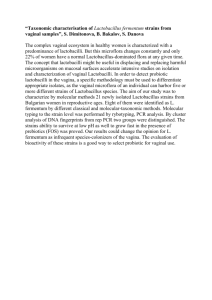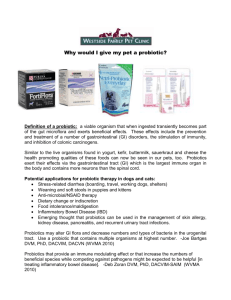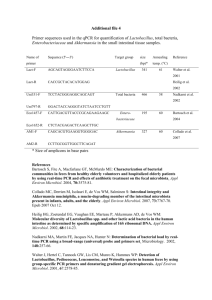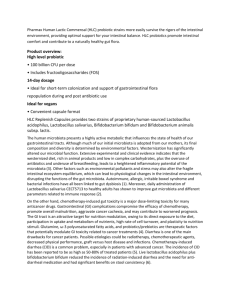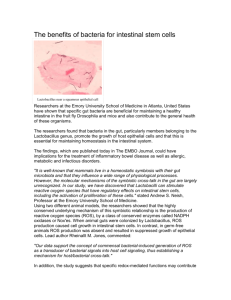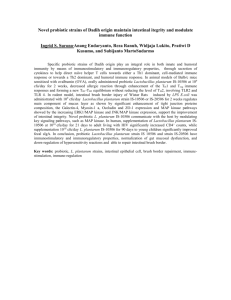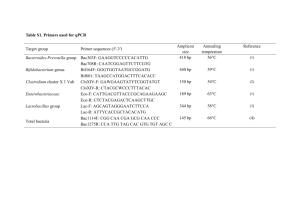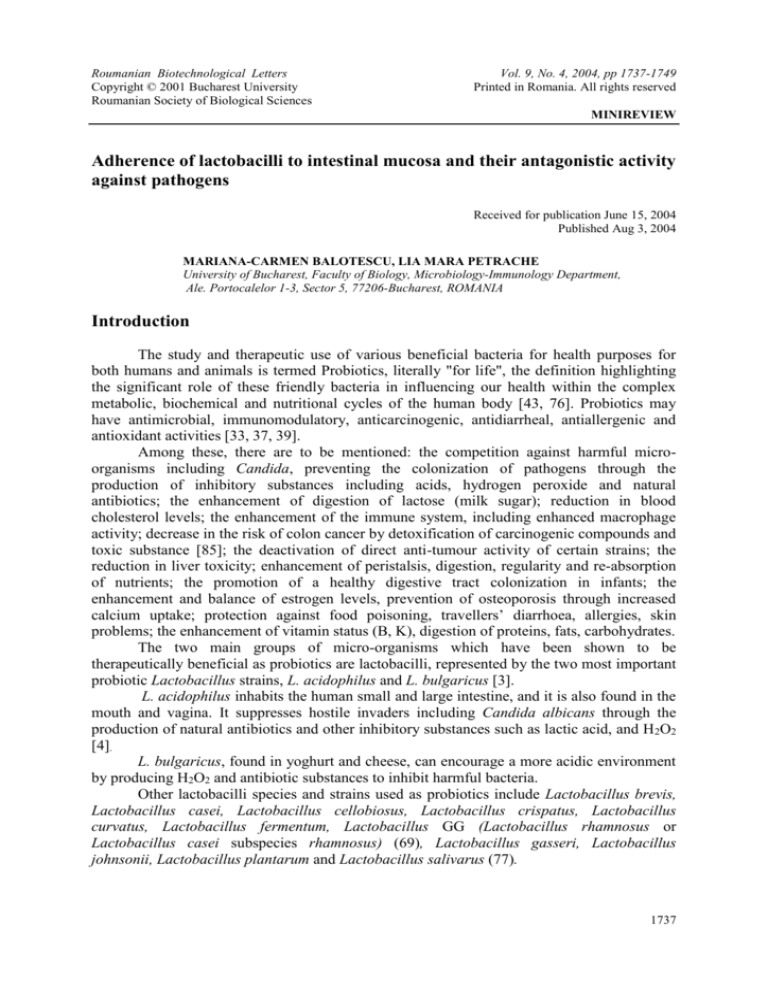
Roumanian Biotechnological Letters
Copyright © 2001 Bucharest University
Roumanian Society of Biological Sciences
Vol. 9, No. 4, 2004, pp 1737-1749
Printed in Romania. All rights reserved
MINIREVIEW
Adherence of lactobacilli to intestinal mucosa and their antagonistic activity
against pathogens
Received for publication June 15, 2004
Published Aug 3, 2004
MARIANA-CARMEN BALOTESCU, LIA MARA PETRACHE
University of Bucharest, Faculty of Biology, Microbiology-Immunology Department,
Ale. Portocalelor 1-3, Sector 5, 77206-Bucharest, ROMANIA
Introduction
The study and therapeutic use of various beneficial bacteria for health purposes for
both humans and animals is termed Probiotics, literally "for life", the definition highlighting
the significant role of these friendly bacteria in influencing our health within the complex
metabolic, biochemical and nutritional cycles of the human body [43, 76]. Probiotics may
have antimicrobial, immunomodulatory, anticarcinogenic, antidiarrheal, antiallergenic and
antioxidant activities [33, 37, 39].
Among these, there are to be mentioned: the competition against harmful microorganisms including Candida, preventing the colonization of pathogens through the
production of inhibitory substances including acids, hydrogen peroxide and natural
antibiotics; the enhancement of digestion of lactose (milk sugar); reduction in blood
cholesterol levels; the enhancement of the immune system, including enhanced macrophage
activity; decrease in the risk of colon cancer by detoxification of carcinogenic compounds and
toxic substance [85]; the deactivation of direct anti-tumour activity of certain strains; the
reduction in liver toxicity; enhancement of peristalsis, digestion, regularity and re-absorption
of nutrients; the promotion of a healthy digestive tract colonization in infants; the
enhancement and balance of estrogen levels, prevention of osteoporosis through increased
calcium uptake; protection against food poisoning, travellers’ diarrhoea, allergies, skin
problems; the enhancement of vitamin status (B, K), digestion of proteins, fats, carbohydrates.
The two main groups of micro-organisms which have been shown to be
therapeutically beneficial as probiotics are lactobacilli, represented by the two most important
probiotic Lactobacillus strains, L. acidophilus and L. bulgaricus [3].
L. acidophilus inhabits the human small and large intestine, and it is also found in the
mouth and vagina. It suppresses hostile invaders including Candida albicans through the
production of natural antibiotics and other inhibitory substances such as lactic acid, and H 2O2
[4].
L. bulgaricus, found in yoghurt and cheese, can encourage a more acidic environment
by producing H2O2 and antibiotic substances to inhibit harmful bacteria.
Other lactobacilli species and strains used as probiotics include Lactobacillus brevis,
Lactobacillus casei, Lactobacillus cellobiosus, Lactobacillus crispatus, Lactobacillus
curvatus, Lactobacillus fermentum, Lactobacillus GG (Lactobacillus rhamnosus or
Lactobacillus casei subspecies rhamnosus) (69), Lactobacillus gasseri, Lactobacillus
johnsonii, Lactobacillus plantarum and Lactobacillus salivarus (77).
1737
MARIANA-CARMEN BALOTESCU, LIA MARA PETRACHE
The Lactobacillus plantarum 299v strain originates in sour dough. Lactobacillus
plantarum itself is of human origin. Other probiotic strains of Lactobacillus are Lactobacillus
acidophilus BG2FO4, Lactobacillus acidophilus INT-9, Lactobacillus plantarum ST31,
Lactobacillus reuteri, Lactobacillus johnsonii LA1, Lactobacillus acidophilus NCFB 1748,
Lactobacillus casei Shirota, Lactobacillus acidophilus NCFM, Lactobacillus acidophilus
DDS-1, Lactobacillus delbrueckii subspecies delbrueckii, Lactobacillus delbrueckii
subspecies bulgaricus type 2038, Lactobacillus acidophilus SBT-2062, Lactobacillus brevis,
Lactobacillus salivarius UCC 118 and Lactobacillus paracasei subspecies paracasei F19.
Lactobacillus plantarum 299v, which is derived from sour dough and which is used to
ferment sauerkraut and salami, has been demonstrated to improve the recovery of patients
with enteric bacterial infections. This bacterium adheres to reinforce the barrier function of
the intestinal mucosa, thus preventing the attachment of pathogenic bacteria to the intestinal
wall, while Lactobacillus GG was found to eradicate Clostridium difficile in patients with
relapsing colitis [27].
Lactobacillus GG has also been shown to inhibit chemically induced intestinal tumors
in rats by binding to some chemical carcinogens, and scavenging superoxide anion radicals,
inhibiting lipid peroxidation and chelating iron in vitro (***). The iron chelating activity of
Lactobacillus GG may account, in part, for its antioxidant activity. Other lactic acid bacteria,
including strains of Lactobacillus acidophilus and Lactobacillus bulgaricus have also shown
antioxidative ability [70]. Mechanisms include chelation of metal ions (iron, copper),
scavenging of reactive oxygen species and reducing activity.
Lactobacillus casei has been demonstrated to increase levels of circulating
immunoglobulin A (IgA) in infants infected with rotavirus. This has been found to be
correlated with a shortened duration of rotavirus-induced diarrhea. Lactobacillus acidophilus
and Bifidobacterium bifidum appear to enhance the nonspecific immune phagocytic activity of
circulating blood granulocytes [14, 18, 22]. This effect may account, in part, for the
stimulation of IgA responses in infants infected with rotavirus. In healthy individuals,
Lactobacillus salivarius UCC118 and Lactobacillus johnsonii LA1 were demonstrated to
produce an increase in the phagocytic activity of peripheral blood monocytes and
granulocytes. Also, Lactobacillus johnsonii LA1, but not Lactobacillus salivarius UCC118,
was found to increase the frequency of interferon-gamma-producing peripheral blood
monocytes.
Adherence and colonization of intestinal mucosa by lactobacilli
The antimicrobial activity of probiotics is thought to be largely accounted for by their
ability to colonize the colon and reinforce the barrier function of the intestinal mucosa [11].
Probiotics, such as Lactobacillus bulgaricus, which do not adhere as well to the intestinal
mucosa, are much less effective against enteric pathogens [47].
Adhesiveness is probably one of the main factors to consider when assessing a strain's
probiotic potential [15, 16, 24, 42, 50, 53]. In the gastrointestinal tract, adhesiveness means
adhesion to cells, mucosa, and other bacteria, because for an inserted probiotic to become
colonized in an environment that has more than 400 microbial species, adhesion to bare
surfaces is unusual [51, 71]. Adherence of these organisms to mucosal structures is generally
believed to facilitate colonization and persistence of lactobacilli and other bacteria in the
normal intestinal population [5, 46, 48]. There are numerous ways to determine the
adhesiveness of bacteria, which is one of the properties required of probiotic products that
provides a scientific basis for the screening and selection of probiotics that compete with
selective groups of pathogens for adhesion to intestinal surfaces [42, 58, 68].
1738
Roum. Biotechnol. Lett., Vol. 9, No. 4, 1737-1749 (2004)
Adherence of lactobacilli to intestinal mucosa and their antagonistic activity against pathogens
Little is known about the surface properties of Lactobacillus that mediate attachment
to human epithelial cell surfaces. Different studies have looked at the specific features of the
surface of Lactobacillus strains [35]. These features include the effect of Lactobacillus on the
hemagglutination of rabbit, sheep, bovine, guinea pig and human erythrocytes, its surface
hydrophobicity, slime production and the adherence of Lactobacillus to two different
epithelial cell lines. These properties were compared by using electron microscopy on the cell
surface. In a few Lactobacillus strains, surface properties such as hemagglutination of human
OP1 erythrocytes, the presence of extracellular slime material and their high degree of
hydrophobicity appeared to be related to one another. The most surface-active strains of
Lactobacillus adhered to both enterocytes and to vaginal cells well. These features seem to be
closely related; however, different adhesions and various mechanisms of attachment may play
a role in the adherence of different Lactobacillus strains to epithelial surfaces.
There are studies describing the ability of the lactobacilli to adhere to enterocytic
epithelial cells in vitro, founding that the bacteria adhered at higher levels to differentiated
rather than undifferentiated epithelial monolayers [7]. Given these results, Caco-2 cell lines
have been widely used to measure the adhesiveness of bacteria in relation to the intestinal
tract [34]. When these cell lines and flow cytometry were combined, adhesion of lactobacilli
was found to vary; isolates from some commercial products (such as LC1 [Nestle, Lausanne,
Switzerland] and GG [Valio, Helsinki, Finland]) were better than those from others
(Lactophilus)] [38]. In a study of adhesion of lactobacilli to mucus from newborns and adults,
the strain Lactobacillus rhamnosus GG adhered best. Perhaps more important, adhesion of the
strains to adult mucus was high. The authors suggest that not all strains may be ideal for
newborns and adults.
Other studies showed that stationary phase lactobacilli were found to adhere to
eukaryotic HT-29 and Caco-2 epithelial cells at greater levels than log phase bacterial cells.
The molecular mechanisms by which lactobacilli adhere to epithelial cells remain
currently unknown [79].
Several studies have suggested that Lactobacillus adherence is mediated by proteins,
while others have suggested a role for lipoteichoic acid and carbohydrate [17, 20, 26].
The potential involvement of surface/exposed protein(s) as bacterial adhesion(s) in
lactobacilli was proven by studies showing that pretreatment of the Lactobacillus cells with
proteolytic enzymes cancelled attachment. SDS-PAGE (denaturing) techniques made the
proteolytic treatment result in the degradation of a cell wall-associated protein of
approximately 84 kDa [31]. The proteinaceous factor was purified by both anion-exchange
chromatography and by gel extraction after SDS-PAGE electrophoresis, and under in vitro
assay conditions proved capable of adherence and significant inhibition of bacterial
attachment to enterocytic epithelial cells.
The protease treatment of the bacterial cells has either not affected or enhanced the
adherence of L. gasseri ADH. Periodate oxidation of bacterial cell surface carbohydrates
significantly reduced adherence of L. gasseri ADH, moderately reduced adherence of L.
acidophilus BG2FO4, and had no effect on adherence of L. acidophilus NCFM/N2. These
results indicate that Lactobacillus species adhere to human intestinal cells via mechanisms
which involve different combinations of carbohydrate and protein factors on the bacterial cell
surface.
Studies on Lactobacillus acidophilus aggregation and adhesiveness have been
demonstrated that L. acidophilus has the ability to establish in the human gastrointestinal
tract, by exhibiting a strong self-aggregating phenotype and manifests a high degree of
hydrophobicity determined by microbial adhesion to xylene, properties mediated by
proteinaceous components on the cell surface [36].
Roum. Biotechnol. Lett., Vol. 9, No. 4, 1737-1749 (2004)
1739
MARIANA-CARMEN BALOTESCU, LIA MARA PETRACHE
Our research showed that all LAB strains exhibited a strong ability to attach to HeLa
cells, showing aggregative and localized adherence pattern. The adherence rate was tested
comparatively for bacterial mid-logarithmic phase cultures as well as for washed bacterial
cells re-suspended in Eagle MEM. Paradoxically, the intensity of the adherence rate was
higher when live bacterial cultures were used, as compared to bacterial washed sediments,
meaning that the intensity of adherence to the cellular substrate is depending on the gradient
of some bacterial compounds secreted and accumulated in the culture medium directly or
indirectly involved in the cell to cell signaling (Lazar et al., 2004).
Cell surface hydrophobicity plays a role as the organisms approach a surface (for
example that of a cell, mucus, or biomaterial). Previous studies have shown that lactobacilli
can have a range of hydrophobic surface properties and that both hydrophobic and hydrophilic
organisms can adhere to epithelial cells, probably via different interlocking mechanisms. The
finding that a particular strain of Lactobacillus fermentum subspecies cellobiosus had a highly
hydrophobic surface similar to that of Salmonella gallinarum implied that the Lactobacillus
strain could block colonization of S. gallinarum [26].
The bacterial adhesion to hydrocarbons (BATH) test was adopted to screen lactic acid
bacteria for cell surface hydrophobicity. The test uses the different distribution of
hydrophobic and hydrophilic strains in a solvent (n-hexadecane)/water system which is
recorded by optical density determination [64].
Heat and protease treatment of bacteria of high surface hydrophobicity, including selfaggregating strains in phosphate-buffered saline, showed a drastic decline in this surface
property. Cultures of selected strains grown in liquid media rich in carbohydrates did not
affect their hydrophobic cell surface character. Therefore, it seems less likely that
carbohydrate capsule polymers are the major determinants of intestinal colonization of
lactobacilli.
The degree of hydrophobicity predicted the adhesion of L. rhamnosus GG to Caco-2
cells. L. rhamnosus GG, however, was able to compete with Escherichia coli and Salmonella
spp. of low hydrophobicity and high adhesion–receptor interaction for adhesion to Caco-2
cells. The interference of adhesion of these gastrointestinal bacteria by L. rhamnosus GG was
probably through steric hindrance and the degree of inhibition was related to the distribution
of the adhesion receptors and hydrophobins on the Caco-2 surface [75]. A Carbohydrate
Index for Adhesion (CIA) was used to depict the binding property of adhesions on bacteria
surfaces. CIA was defined as the sum of the fraction of adhesion in the presence of
carbohydrates, with reference to the adhesion measured in the absence of any carbohydrate.
The degree of competition for receptor sites between Lactobacillus casei Shirota and GI
bacteria is a function of their CIA distance. There were at least two types of adhesions on the
surface of L. casei Shirota.
Binding of lactobacilli to extracellular matrix (ECM) proteins (collagen (Cn) human
type I and IV, fibrinogen (Fb) and fibronectin (Fn) may be also involved in the colonization
of the intestinal mucosa by lactobacilli [83].
Although the gastrointestinal tract is the main target of available probiotic cultures —
and indeed most definitions of probiotics refer to intestinal site of action —probiotic
organisms have applications at other sites, such as the urogenital tract, nasopharynx, wounds,
and elsewhere. Lactobacillus rhamnosus GR-1, Lactobacillus fermentum RC-14, and
Lactobacillus fermentum B-54 have antipathogen properties and colonize the intestine and
vagina, conferring health benefits to women [62]. These strains have been found to adhere to
vaginal cells, hemagglutinate red blood cells and produce biosurfactants.
Lactobacilli form the large part of vagina microbiota that generating a
microenvironment usually capable of protecting the host from infectious diseases, including
1740
Roum. Biotechnol. Lett., Vol. 9, No. 4, 1737-1749 (2004)
Adherence of lactobacilli to intestinal mucosa and their antagonistic activity against pathogens
some that are sexually transmitted or which increase the risk of preterm labor [62, 74].
Nevertheless, statistically every woman will suffer from yeast, bacterial vaginosis, or urinary
tract infection at some point in her life [72, 73]. A number of factors are believed to be
important for lactobacilli to colonize the urogenital and intestinal tracts and reduce the risk of
infection [8, 9]. Adhesion to cells and mucus is believed to be one of the main factors when it
coincides with survival of the organism and inhibition of growth and adhesion of pathogens
[63].
Little is known about the mechanisms by which lactobacilli from the vaginas of
healthy young women adhere to vaginal epithelial cells, although the variety of surface
structures in these bacteria implies that a spectrum of adherence mechanisms may exist (2).
Furthermore, self-aggregation may substantially increase the colonization potential of
lactobacilli in environments with short residence times.
The study of adhesion with respect to the intestine has been done primarily with
CaCo-2 cells, and the clinical relevance of the adhesion values has been questioned. It would
require intestinal biopsies to fully correlate adhesion in vitro with those obtained in vivo. Even
then, given the fact that dense biofilms of organisms coat the mucus and cells of the intestine,
the level of adhesion to cells may not be as critical as an ability to adhere to and penetrate
existing biofilms. For the vagina, it is easier to obtain cells and determine if in vitro data
correlates with in vivo findings. Adhesions can be detected by hemagglutination reactions
(essentially binding of bacteria to blood cells), and a classification system has been reported
using hemagglutination to separate strains that would be potentially good probiotic agents
from those that would not.
Both self-aggregation and adhesion may favor the colonization of the vaginal
epithelium through the formation of a bacterial film that may contribute to the exclusion of
pathogens from the vaginal mucosa.
Multiple components of the bacterial cell surface seem to participate in the adherence
of the strains to vaginal epithelial cells. In L. acidophilus and L. gasseri, adherence involved
proteins and carbohydrate (possibly a glycoprotein), while L. jensenii adherence seemed to
depend exclusively on carbohydrates (6). In L. gasseri and L. jensenii, divalent cations,
probably Ca2+, were also involved in adherence, as judged by sensitivity to EDTA and EGTA.
This diversity of adherence requirements was reported before, although it was for the
digestive epithelium. Thus, L. fermentum adherence to mouse squamous epithelium was
sensitive to chelating agents, while colonization of chicken tissue by L. acidophilus was not.
However, the adherence factors seem to be different from those that mediate the selfaggregation of the strains; for example, L. jensenii self-aggregation depends on lipoproteins,
while adherence to vaginal cells relies on carbohydrates.
Competition with pathogens in mucosal colonization
Knowledge of the predominant genera and species of the gastrointestinal microflora as
well as determination of their levels and biochemical activities are essential in the
understanding of the microbial ecology of the gastrointestinal tract. The normal resident
gastrointestinal microflora contains many diverse populations of bacteria which play an
essential role in the development and well being of the host [67]. By continual release of
antibiotic proteins, specialized cells of the intestinal epithelium may influence the extracellular
environment and contribute to mucosal barrier function. In addition to the host cell nonimmune system of defense, bacteria of the resident gut microflora exert a barrier effect against
pathogens. It was recently reported that Escherichia coli, one of the first bacterial genera that
colonize the intestine of humans, display antimicrobial activity against salmonella infection
Roum. Biotechnol. Lett., Vol. 9, No. 4, 1737-1749 (2004)
1741
MARIANA-CARMEN BALOTESCU, LIA MARA PETRACHE
[30, 32]. Other species of the endogenous human microflora such as bifidobacteria, a major
species of the colonic microflora, and lactobacilli, a minor species of the gut microflora, exert
antimicrobial activity by producing secreted antimicrobial substances [23, 41, 45].
During the past decades, the beneficial effect of specific lactic acid bacteria (LAB)
strains in preventing or treating intestinal disorders has been substantiated by well-controlled
clinical trials [21]. Increasing evidence, including human studies, is also supporting the
immunomodulatory role attributed to given lactic acid bacterial strains [66]. To gain further
insight into the mechanism by which resident bacteria of the human microflora could exert a
protective role against enterovirulent pathogen induced cellular damage, it was examined the
activity of a Lactobacillus acidophilus strain isolated from the resident adult human
microflora for which the production of secreted antimicrobial substances has been well
established both in vitro and in vivo [65].
To infect host cells, microbial pathogens use very sophisticated mechanisms of
pathogenicity. Many enteroadherent and enteroinvasive pathogens hijack the host cell signal
transducing pathways and/or target the host cytoskeleton molecules that play a pivotal role in
cell architecture, thus promoting development of diarrhoea. It is well known that Ca2+
regulated events play a key role in the disassembly brush border organization leading to
functional disorders promoting diarrhoea. It was established that the mechanism by which the
strain LB by its SCS (Spent Culture Supernatant) exerts a protective effect against the one
Enteropathogenic E. coli (EPEC) strain is an antagonistic activity results from interference
with EPEC induced cell signaling. An identical mechanism of action — that is, inhibition of
the cross talk between a pathogen and target host cells — has previously been reported with
antibiotics.
Few studies of the exclusion or reduction of pathogen adhesion have been reported
recently. Lactobacilli were shown to produce anti-pathogen adhesion substances, the crude
mixture of which is termed biosurfactants, and a recent study showed that this inhibitory
effect can extend to a wide range of virulent pathogens [59]. Presumably, these primarily
proteinaceous biosurfactants are produced in situ, perhaps aided by lower pH. Human
phospholipids (referred to as biosurfactants, although this is incorrect because other bacteria
can produce lipid biosurfactants and the term should be retained for bacterial, not human
compounds) play a role in cell membrane fluidity and permeability, helping to prevent
pathogen translocation. These lipids are dependent on fatty acids. It has been shown that a
strain of Lactobacillus plantarum can increase fatty acid content in the intestine, adhere and
interfere with pathogen adhesion and translocation (perhaps by competitive binding to
mannose receptors), and eliminate nitrate.
It has been suggested that by combining ingestion of this strain with various fibers and
polar lipids, the gastrointestinal mucosa can be reconditioned and the risk for infection can be
reduced.
Because LAB are known to exist in the intestines and exert antibacterial activity on
intestinal pathogens and because the stomach is a very harsh environment, with low pH and
the presence of pepsin, most researchers have assumed that LAB cannot inhibit gastric
pathogens.
Among the 100 LAB isolated in infant feces, several isolates that showed good
inhibitory activity on the adherence of Helicobacter pylori to glycolipid spotted on a thinlayer chromatography plate were selected. One isolate, which showed the best inhibitory
activity on the growth of H. pylori in a well test, was selected and characterized [25, 49].
When H. pylori was treated with the SCS (Spent Culture Supernatant), the cells changed from
helical shape to coccoid shape and became necrotic, even after treatment with the neutralized
SCS [10]. A similar coccoid shape was observed with H. pylori treated with amoxicillin;
1742
Roum. Biotechnol. Lett., Vol. 9, No. 4, 1737-1749 (2004)
Adherence of lactobacilli to intestinal mucosa and their antagonistic activity against pathogens
others have previously observed the same result after treatment with the SCS of L.
acidophilus, and this form is known to result in a loss of infectivity. Because the neutralized
SCS had the same effect, there must be a factor(s) for necrosis in addition to lactic acid and
low pH.
The binding activity of nonviable LAB suggests that LAB binds directly to the
stomach via a mechanism similar to that involved in the binding of LAB to the intestinal
epithelial cells and that nonviable as well as viable LAB can prevent the adherence of H.
pylori to the stomach. Such LAB strains with dual inhibitory activity on H. pylori—
bactericidal activity and prevention of adherence to gastric mucous cells—has the potential to
be developed as a new probiotic for the stomach.
Lactobacilli are believed to interfere with genitourinary pathogens by different
mechanisms [55, 80, 81]. The first is competitive exclusion of genitourinary pathogens from
receptors present on the surface of the genitourinary epithelium [12, 44]. Second, lactobacilli
co-aggregate with some uropathogenic bacteria, a process that, when linked to the production
of antimicrobial compounds, such as lactic acid, hydrogen peroxide, bacteriocin-like
substances, and possibly biosurfactants, would result in inhibition of the growth of the
pathogen [52, 56, 57, 58, 82].
A lot of studies have demonstrated that the vaginal lactobacilli interfered with the
adherence of genitourinary pathogens [28]. In this respect, it is interesting to note first that
Candida (C) albicans and Gardnerella vaginalis adhered to vaginal epithelial cells, while
E. coli and S. agalactiae did not [40]. Since the first two organisms produce pathology
primarily at the vaginal level, while the others are just opportunistic pathogens, it may be
deduced that adherence is an important virulence factor.
It is possible that L. acidophilus and G. vaginalis bind to the same receptors on the
surfaces of vaginal epithelial cells [29, 85]. It appears that the affinity of L. acidophilus for
those receptors is higher than that of G. vaginalis, as deduced by the displacement by
L. acidophilus of adherent cells of G. vaginalis.
Finally, there are studies showing that the vaginal lactobacilli co-aggregated with all
of the pathogens, with the exception of S. agalactiae, suggesting that this process is somewhat
specific [60, 61]. The co-aggregation may well impede the access of pathogens to tissue
receptors and in fact may be an alternative explanation for the lack of adherence of C. albicans
and G. vaginalis to vaginal epithelial cells in the presence of lactobacilli [54, 78].
Our results showed that the original LAB cultures, washed bacterial cells, or culture
supernatant largely reduced the attachment of the tested pathogenic strains to HeLa cells (5 to
a 10% adherence rate of pathogenic bacteria in the presence of the tested LAB preparations),
but compared to the original LAB cultures (under 1% adherence rate of pathogenic bacteria in
the presence of LAB whole cultures), washed cells or culture supernatant inhibited the
adhesion of tested pathogens to a lesser degree (Smarandache et al., 2004; Lazar et al., 2004).
However, this inhibiting activity was recovered after the washed cells and the
supernatant were recombined, with the recombined mixture having a similar inhibitory ability
to that of the original LAB cultures (pathogenic bacteria not adhered to HeLa cells). This
result may imply that the substances from both LAB cells and the spent culture supernatant
contribute to the inhibition of adhesion of pathogens to the HeLa strains (Lazar et al., 2004).
The inhibitory effects of LAB on adherence capacity of pathogens have been
attributed to the steric hindrance of binding sites, pH values, or certain components of the
lysed cell. The results of our studies support the idea that LAB cells or the substances released
in its culture might occupy the binding sites, although these binding sites are not necessarily
targeting the same epitopes in pathogenic strains.
Roum. Biotechnol. Lett., Vol. 9, No. 4, 1737-1749 (2004)
1743
MARIANA-CARMEN BALOTESCU, LIA MARA PETRACHE
The culture pH has been suggested to be an important factor in the inhibition of
adhesion of pathogens to the mucosa. In the current study, the inhibiting effect was not solely
a pH effect, since considerable inhibitory action was demonstrated after washing the bacterial
cells and re-suspending them in EagleMEM and adjusting the bacterial suspension used for
inoculation of cell monolayer to pH 7.0 (Lazar et al., 2004).
In the case of culture supernatants, we have to mention that a strong lytic effect, that
was not recovered when washed bacterial cells or original cultures were used, was noticed on
pathogenic bacterial cells. This could be due to the presence of lytic enzymes in bacterial
culture supernatants. Paradoxically, this lytic effect was not observed when original bacterial
cultures were used. These results are pleading for the existence of complex regulatory and
signaling mechanisms present in original cultures, that are lost when bacterial supernatants are
used. However, further in-depth studies on a large number of pathogenic strains are needed in
order to confirm these results.
We have also demonstrated, by in vivo studies that, beside the local, antipathogenic
effect manifested at intestinal level, the probiotic Lctobacillus casei GG strain exhibit also an
immunoadjuvant effect, when administered against enteropathogenic bacteria, together with
fimbrial antigens by oral route (Dima et al., 2002). The immunostimulatory effect was not
only local (at the Peyer’s patches and intestinal lymph nodes level, but also systemic,
highlighted by the lymphocyte proliferation in spleen) (Dima et al., 2000).
This brief review presented the existent data on the role of lactobacilli adherence in the
colonization of different mucosal surfaces or their persistence in host ecosystems after
administration as probiotics. However, in vitro tests showed that adherence is highly
dependent on certain physiological conditions (e.g. pH conditions not found in natural host
ecosystems), and no correlation was observed between the in vivo findings and adherence of a
certain bacterial strain to epithelial cells or cell lines [3, 19]. So we have to take into account
the prediction limits of the in vitro cell culture models which cannot predict the success of a
strain as a colonizer of human mucosal surfaces. The knowledge of the natural colonization
pattern of lactobacilli in human is still rudimentary and more research is needed to confirm
the role of adherence in colonization and persistence.
References
1. ***Lactobacillus GG. Nutrition Today. 31, 1S-52S (1996).
2. ANDREU, A., A. E. STAPLETON, C. L. FENNELL, S. L. HILLIER, AND W. E.
STAMM, Hemagglutination, adherence and surface properties of vaginal Lactobacillus
species, J. Infect. Dis. 171, 1237-1243 (1995).
3. BARROW, P. A., P. E. BROOKER, R. FULLER, AND M. J. NEWPORT, The
attachment of bacteria to the gastric epithelium of the pig and its importance in the
microecology of the intestine, J. Appl. Bacteriol 48, 147-154 (1980).
4. BERNET, M. F., D. BRASSART, J. R. NEESER, A. L. SERVIN, Lactobacillus
acidophilus LA 1 binds to cultured human intestinal cell lines and inhibits cell attachment
and cell invasion by enterovirulent bacteria, Gut 35, 483-489 (1994).
5. BLUM S, RENIERO R, SCHIFFRIN EJ, ET AL, Adhesion studies for probiotics: need
for validation and refinemen, Trends Food Sci Technol, 10 405-410 (1999).
6. BORIS, S., J. E. SUAREZ, AND C. BARBES, Characterization of the aggregation
promoting factor from Lactobacillus gasseri, a vaginal isolate, J. Appl. Microbiol. 83,
413-420 (1997).
1744
Roum. Biotechnol. Lett., Vol. 9, No. 4, 1737-1749 (2004)
Adherence of lactobacilli to intestinal mucosa and their antagonistic activity against pathogens
7. BROOKER, B. E., AND R. FULLER, Adhesion of lactobacilli to the chicken crop
epithelium, J. Ultrastruct. Res, 52, 21-31 (1975).
8. BRUCE, A. W., G. REID, J. A. MCGROARTY, M. TAYLOR, C. PRESTON,
Preliminary study on the prevention of recurrent urinary tract infections in ten adult
women using intravaginal lactobacilli, Int. Urogynecol. J., 3, 22-25 (1992).
9. BRUCE, A. W., G. REID, Intravaginal instillation of lactobacilli for prevention of
recurrent urinary tract infections. Can. J. Microbiol, 34, 339-343 (1988).
10. CATERNICH, C. E., AND K. M. MAKIN, Characterization of the morphological
conversion of Helicobacter pylori from bacillary to coccoid forms, Scand. J.
Gastroenterol. 26, 58-64 (1991).
11. CHAITOW L, TRENEV N., Probiotics – How to use "friendly bacteria" to restore total
health and vitality, Thorsons, 1990.
12. CHAN, R. C. Y., G. REID, R. T. IRVIN, A. W. BRUCE, AND J. W. COSTERTON,.
Competitive exclusion of uropathogens from human uroepithelial cells by Lactobacillus
whole cells and cell wall fragments, Infect. Immun, 47, 84-89 (1985).
13. COCONNIER MH, LIÉVIN V, LORROT M, et al. Antagonistic activity of Lactobacillus
acidophilus LB against intracellular Salmonella enterica serovar typhimurium infecting
human enterocyte-like Caco-2/TC-7 cells. Appl Environ Microbiol; 64, 4573–80 (2000).
14. COCONNIER, M. H., V. LIEVIN, M.-F. BERNET-CAMARD, S. HUDAULT, AND A.
L. SERVIN,. Antibacterial effect of the adhering human Lactobacillus acidophilus strain
LB, Antimicrob. Agents Chemother, 41, 1046-1052 (1997).
15. COLLINS, J. K., G. THORNTON, G. O’SULLIVAN, Selection of probiotic strains for
human applications, Int. Dairy J. 8, 487-490 (1998).
16. CONWAY, P. L. Selection criteria for probiotic microorganisms. Asia Pacific J. Clin.
Nutr. 5, 10-14. (1996).
17. CONWAY, P. L., AND S. KJELLEBERG, Protein-mediated adhesion of Lactobacillus
fermentum strain 737 to mouse stomach squamous epithelium. J. Gen. Microbiol. 135,
1175-1186 (1989).
18. DUGAS B, MERCENIER A, LENOIR-WIJNKOOP I, ET AL., Immunity and probiotics.
Immunol Today, 20, 387-390 (1999).
19. DUNNE, C., L. O'MAHONY, L. MURPHY, G. THORNTON, D. MORRISSEY, S.
O'HALLORAN, M. FEENEY, S. FLYNN, G. FITZGERALD, C. DALY, B. KIELY, G.
C. O'SULLIVAN, F. SHANAHAN, J. K. COLLINS, In vitro selection criteria for
probiotic bacteria of human origin: correlation with in vivo findings. Am. J. Clin. Nutr. 73,
386S-392S (2001).
20. FULLER, R., Nature of the determinant responsible for the adhesion of lactobacilli to
chicken crop epithelial cells, J. Gen. Microbiol. 87, 245-250 (1975).
21. GIONCHETTI P, RIZZELLO F, VENTURI A, CAMPIERI M., Probiotics in infective
diarrhoea and inflammatory bowel diseases, J Gastroenterol Hepatol. 15, 489-493 (2000).
22. GOMES AMP, MALCATA FX.. Bifidobacterium spp. and Lactobacillus acidophilus:
biological, biochemical, technological and therapeutical properties relevant for use as
probiotics. Trends Food Sci Technol. 10, 139-157 (1999).
23. GORBACH SL., Lactic acid bacteria and human health, Ann Med. 22, 37-41 (1990).
24. GUARNER, F., G. J. SCHAAFSMA, Probiotics. Int. J. Food Microbiol. 39, 237-238.
(1998).
25. HEMALATHA, S. G., B. DRUMM, AND P. SHERMAN, Adherence of Helicobacter
pylori to human gastric epithelial cells in vitro. J. Med. Microbiol. 35, 197-202 (1991).
Roum. Biotechnol. Lett., Vol. 9, No. 4, 1737-1749 (2004)
1745
MARIANA-CARMEN BALOTESCU, LIA MARA PETRACHE
26. HENRIKSSON, A., R. SZEWZYK, AND P. L. CONWAY, Characteristics of the
adhesive determinants of Lactobacillus fermentum 104. Appl. Environ. Microbiol. 57,
499-502 (1991).
27. HERIAS MV, HESSLE C, TELEMO E, ET AL, Immunomodulatory effects of
Lactobacillus plantarum colonizing the intestine of gnotobiotic rats. Clin Exp Immunol.
116, 283-290 (1999).
28. HILTON, E., H. D. ISENBERG, P. ALPERSTEIN, K. FRANCE, AND M. T.
BORENSTEIN, Ingested yogurt as prophylaxis for chronic candidal vaginitis. Ann.
Intern. Med. 116, 353-357 (1992).
29. HOOD SK, ZOTTOLA EA, An electron microscopic study of the adherence of
Lactobacillus acidophilus to human intestinal cells in vitro, Food Microstructure. 8, 91-7.
(1989).
30. HOOPER LV, WONG MH, THELIN A, et al. Molecular analysis of commensal hostmicrobial relationships in the intestine. Science; 291, 881–4 (2001).
31. HOWARD, J., C. HEINEMANN, B. J. THATCHER, B. MARTIN, B. S. GAN, G. REID,
Identification of collagen-binding proteins in Lactobacillus spp. with surface-enhanced
laser desorption/ionization-time of flight ProteinChip technology. Appl. Environ.
Microbiol. 66 4396-4400 (2000).
32. HUDAULT S, GUIGNOT J, SERVIN AL. Escherichia coli strains colonising the
gastrointestinal tract protect germfree mice against Salmonella typhimurium infection.
Gut; 49 47–55 (2001).
33. ISOLAURI, E., Y. SUTAS, P. KANKAANPAA, H. ARVILOMMI, S. SALMINEN..
Probiotics: effects on immunity. Am. J. Clin. Nutr. 73, 444S-450S (2001).
34. KIMOTO H, KURISAKI MN, TSUJI, et al., Lactococci as probiotic strains: adhesion to
human enterocyte-like Caco-2 cells and tolerance to low pH and bile. Lett Applied
Microbiol. 29, 313-316 (1999).
35. KIRJAVAINEN PV, OUWEHAND AC, ISOLAURI E, SALMINEN SJ. The ability of
probiotic bacteria to bind to human intestinal mucus. FEMS Microbiol Lett. 167, 185-189
(1998).
36. KOS, B, U KOVIC´, J., VUKOVIC´, S., IMPRAGA, M., FRECE, J., MATO IC´, S.
Adhesion and aggregation ability of probiotic strain Lactobacillus acidophilus M92. J.
Appl. Microbiol. 94 (6), 981-987 (2003).
37. LEE, Y. K., S. SALMINEN, The coming of age of probiotics. Trends Food Sci. Technol.
6, 241-245 (1995).
38. LIÉVIN-LE MOAL, V., AMSELLEM, R., SERVIN, A.,L., COCONNIER, M-H.,
Lactobacillus acidophilus (strain LB) from the resident adult human gastrointestinal
microflora exerts activity against brush border damage promoted by a diarrhoeagenic
Escherichia coli in human enterocyte-like cells. Gut 50, 803-811 2002. Correspondence
to: A L Servin, Faculté de Pharmacie Paris XI, INSERM Unité 510, F-92296 ChãtenayMalabry, France; alain.servin@cep.u-psud.fr.
39. LIN M-Y, YEN C-L.. Antioxidative ability of lactic acid bacteria. J Agric Food Chem. 47,
1460-1466 (1999).
40. LINDGREN S, GULLMAR B., J.E. SUAREZ, F. VAZQUEZ, C. BARBES, Adherence
of Human Vaginal Lactobacilli to Vaginal Epithelial Cells and Interaction with
Uropathogens, Infect Immun, 66, 1985-1989 (1998).
41. MACK DR, MICHAIL S, WEI S, et al.. Probiotics inhibit enteropathogenic E. coli
adherence in vitro by inducing intestinal mucin gene expression. Am J. Physiol. 276
(4 Pt 1), G941-G950 (1999).
1746
Roum. Biotechnol. Lett., Vol. 9, No. 4, 1737-1749 (2004)
Adherence of lactobacilli to intestinal mucosa and their antagonistic activity against pathogens
42. MATILLA-SANDHOLM T, BLUM S, COLLINS JK, et al. Probiotics: towards
demonstrating efficacy. Trends Food Sci Technol. 10, 393-399 (1999).
43. MATTILA-SANDHOLM T. The PROBDEMO project: demonstration of the nutritional
functionality of probiotic foods. Trends Food Sci Technol. 10, 385-386 (1999).
44. MCGROARTY, J. A.. Probiotic use of lactobacilli in the human female urogenital tract.
FEMS Immunol. Med. Microbiol. 6, 251-264 (1993. ).
45. MCGROARTY, J. A., G. REID. Detection of a Lactobacillus substance that inhibits
Escherichia coli. Can. J. Microbiol. 34, 974-978 (1988).
46. MORELLI, L., In vitro selection of probiotic lactobacilli: a critical appraisal. Curr. Issues
Intest. Microbiol. 1, 59-67 (2000).
47. NABILA IBNOU-ZEKRI, STEPHANIE BLUM, EDUARDO J. SCHIFFRIN, THIERRY
VON DER WEID. Divergent Patterns of Colonization and Immune Response Elicited
from Two Intestinal Lactobacillus Strains That Display Similar Properties In vitro.
Infection and Immunity, January, 71, 428-436 (2003).
48. NAIDU, A. S., W. R. BIDLACK, R. A. CLEMENS. Probiotic spectra of lactic acid
bacteria (LAB). Crit. Rev. Food Sci. Nutr. 38, 13-126 (1999).
49. NAM, H., HA, M., BAE, O., LEE, Y., Effect of Weissella confusa Strain PL9001 on the
Adherence and Growth of Helicobacter pylori. Applied and Environmental Microbiology.
68, 4642-4645 (2002).
50. O'BRIEN J, CRITTENDEN R, OUWEHAND AC, SALMINEN S. Safety evaluation of
probiotics. Trends Food Sci Technol. 10, 418-424 (1999).
51. OUWEHAND AC, TÖLKKÖ S, KULMALA J, ET AL. Adhesion of inactivated
probiotic strains to intestinal mucus. Lett Applied Microbiol, 31, 82-86 (2000).
52. REDONDO-LOPEZ, V., R. L. COOK, AND J. D. SOBEL. Emerging role of lactobacilli
in the control and maintenance of the vaginal bacterial microflora. Rev. Infect. Dis. 12,
856-872 (1990).
53. REID, G. Testing the efficacy of probiotics. Pages 129-140 in Probiotics: a critical
review. G. W. Tannock, ed. Horizon Scientific Press, Wynmondham, United Kingdom,
(1999).
54. REID, G. The scientific basis for probiotic strains of Lactobacillus. Appl. Environ.
Microbiol. 65, 3763-3766 (1999).
55. REID, G. In vitro testing of Lactobacillus acidophilus NCFM TM as a possible probiotic
for the urogenital tract. Int. Dairy J. 10, 415-419 (2000).
56. REID, G. Therapeutic use of lactobacilli. American Dairy Science Association and
American Society of Animal Science Joint Meeting, Mini Symposium on Lactobacilli,
Baltimore, MD, July 24-25, 2000.
57. REID, G., A. W. BRUCE, M. TAYLOR. Influence of three day antimicrobial therapy and
lactobacillus suppositories on recurrence of urinary tract infection. Clin. Therapeutics 14
(1), 11-16 (1992).
58. REID, G., A. W. BRUCE, M. TAYLOR. Instillation of Lactobacillus and stimulation of
indigenous organisms to prevent recurrence of urinary tract infections. Microecol. Ther.
23, 32-45 (1995).
59. REID, G., A. W. BRUCE. Selection of Lactobacillus for urogenital probiotic applications.
J. Infect. Dis. 183(Suppl. 1), S77-S80 (2001).
60. REID, G., C. HEINEMANN, M. VELRAEDS, H. C. VAN DER MEI, H. J. BUSSCHER.
Biosurfactants produced by Lactobacillus. Methods Enzymol. 310, 426-432 (1999).
61. REID, G., J. A. MCGROARTY, P. A. GIL DOMINGUE, A. W. CHOW, A. W. BRUCE,
A. EISEN, AND J. W. COSTERTON. Coaggregation of urogenital bacteria in vitro and in
vivo. Curr. Microbiol. 20, 47-52 (1990).
Roum. Biotechnol. Lett., Vol. 9, No. 4, 1737-1749 (2004)
1747
MARIANA-CARMEN BALOTESCU, LIA MARA PETRACHE
62. REID, G., J. A. MCGROARTY, R. ANGOTTI, AND R. L. COOK. Lactobacillus
inhibitor production against Escherichia coli and coaggregation ability with uropathogens.
Can. J. Microbiol. 34, 344-351 (1988).
63. REID, G., K. MILLSAP, A. W. BRUCE. Implantation of Lactobacillus casei var
rhamnosus into the vagina. Lancet 344, 1229 (1994).
64. REID, G., R. L. COOK, A. W. BRUCE. Examination of strains of lactobacilli for
properties which may influence bacterial interference in the urinary tract. J. Urol. 38, 330335 (1987).
65. ROSENBERG, M., D. GUTNICK, AND E. ROSENBERG. Adherence of bacteria to
hydrocarbons: a simple method for measuring cell-surface hydrophobicity. FEMS
Microbiol. Lett. 9, 29-33 (1980).
66. SAAVEDRA J. Probiotics and infectious diarrhea. Am J Gastroenterol. 95(1 Suppl), S16S18 (2000).
67. SALMINEN, S., A. G. OUWEHAND, E. ISOLAURI. Clinical applications of probiotic
bacteria. Int. Dairy J. 8, 563-572 (1998).
68. SAXELIN M, GRENOV B, SVENSSON U et al. The technology of probiotics. Trends
Food Sci Technol. 10, 387-392.
69. SAXELIN, M. Lactobacillus GG-a human probiotic strain with thorough clinical
documentation. Food Rev. Int. 13, 293-313 (1997).
70. SAXELIN, M., S. ELO, S. SALMINEN, H. VAPAATALO. Dose response colonisation
of faeces after administration of Lactobacillus casei strain GG. Microbiol. Ecol. Health
Dis. 4, 209-214 (1991).
71. SHORTT C. The probiotic century: historical and current perspectives. Trends Food Sci
Technol. 10, 411-417 (1999).
72. SOBEL, J. D. Candidal vulvovaginitis. Clin. Obstet. Gynecol. 36, 153-166 (1993).
73. SOBEL, J. D. Vaginitis and vaginal flora: controversies abound. Curr. Opin. Infect. Dis.
9, 42-47 (1996).
74. SOBEL, J. D. Biotherapeutic agents as therapy for vaginitis. Pages 221-224 in
Biotherapeutic Agents and Infectious Diseases. G. W. Elmer, L. McFarland, and C.
Surawicz, ed. Humana Press, Totowa, NJ. Sprunt, K., and G. Leidy. 1988. The use of
bacterial interference to prevent infection. Can. J. Microbiol. 34(3), 332-338 (1999).
75. SPENCER, R. J., AND A. CHESSON. The effect of Lactobacillus spp. on the attachment
of enterotoxigenic Escherichia coli to isolated porcine enterocytes. J. Appl. Bacteriol. 77,
215-220 (1994).
76. SYMPOSIUM: Probiotic Bacteria: Implications for Human Health. J Nutr. 130, 382S409S (2000).
77. TANNOCK, G. W., K. MUNRO, H.J.M. HARMSEN, G. W. WELLING, J. SMART, P.
K. GOPEL. Analysis of the fecal microflora of human subjects consuming a probiotic
product containing Lactobacillus rhamnosus RD20. Appl. Environ. Microbiol. 66, 25782588 (2000).
78. VANDEVOORDE, L., N. CHRISTIAENS, AND W. VERSTRAETE. Prevalence of coaggregation reactions among chicken lactobacilli. J. Appl. Bacteriol. 72, 214-219 (1992).
79. VAUGHAN EE, HEILIG HGHJ, ZOETENDAL EG, et al. Molecular approaches to study
probiotic bacteria. Trends Food Sci Technology. 10, 400-404 (1999).
80. VELRAEDS, M. C. M., H. C. VAN DER MEI, G. REID, AND H. J. BUSSCHER.
Inhibition of initial adhesion of uropathogenic Enterococcus faecalis by biosurfactants
from Lactobacillus isolates. Appl. Environ. Microbiol. 62, 1958-1963 (1996).
81. VELRAEDS, M. C., B. VAN DER BELT, H. C. VAN DER MEI, G. REID, H. J.
BUSSCHER. Interference in initial adhesion of uropathogenic bacteria and yeasts silicone
1748
Roum. Biotechnol. Lett., Vol. 9, No. 4, 1737-1749 (2004)
Adherence of lactobacilli to intestinal mucosa and their antagonistic activity against pathogens
rubber by a Lactobacillus acidophilus biosurfactant. J. Med. Microbiol. 49, 790-794
(1998).
82. VELRAEDS, M. C., H. C. VAN DER MEI, G. REID, H. J. BUSSCHER. Inhibition of
initial adhesion of uropathogenic Enterococcus faecalis by biosurfactants from
Lactobacillus isolates. Appl Environ Microbiol. 62, 1958-1963 (1996).
83. WADSTRÖM, T., K. ANDERSSON, M. SYDOW, L. AXELSSON, S. LINDGREN,
AND B. GULLMAR. Surface properties of lactobacilli isolated from the small intestine of
pigs. J. Appl. Microbiol. 62, 513-520 (1987).
84. WOLLOWSKI I, JI S-T. BAKALINSKY AT, et al. Bacteria used for the production of
yogurt inactivate carcinogens and prevent DNA damage in the colon of rats. J Nutr.
129:77-82 (1999).
85. WOOD, J. R., R. L. SWEET, A. CATENA, W. K. HADLEY, AND M. ROBBIE.. In vitro
adherence of Lactobacillus species to vaginal epithelial cells. J. Obstet. Gynecol. 153,
740-743 (1985).
Roum. Biotechnol. Lett., Vol. 9, No. 4, 1737-1749 (2004)
1749

